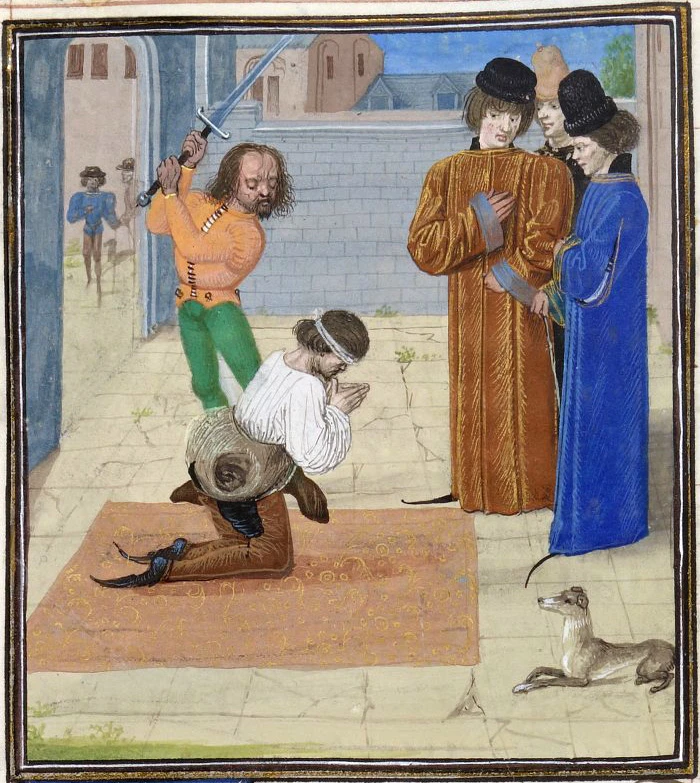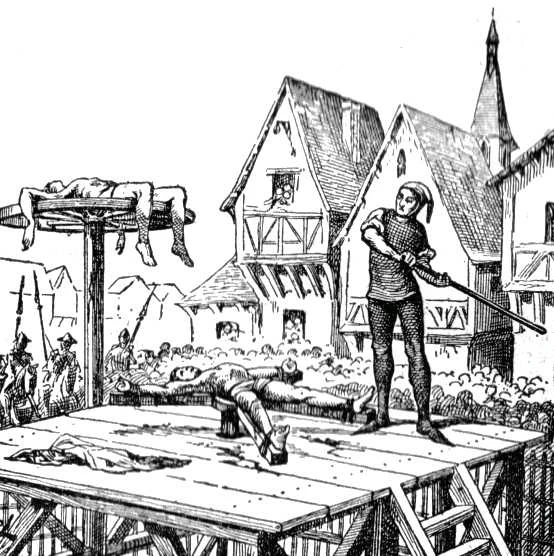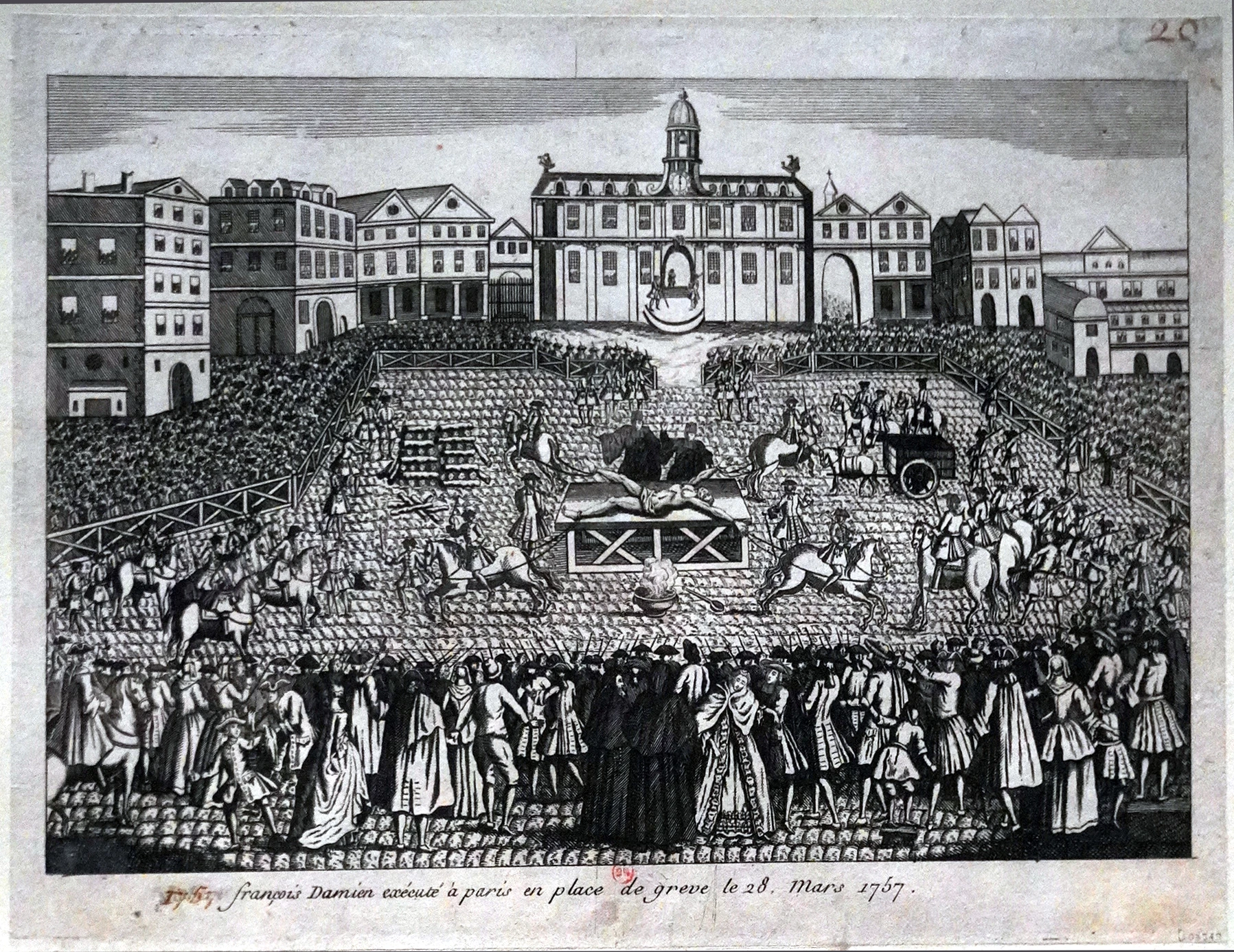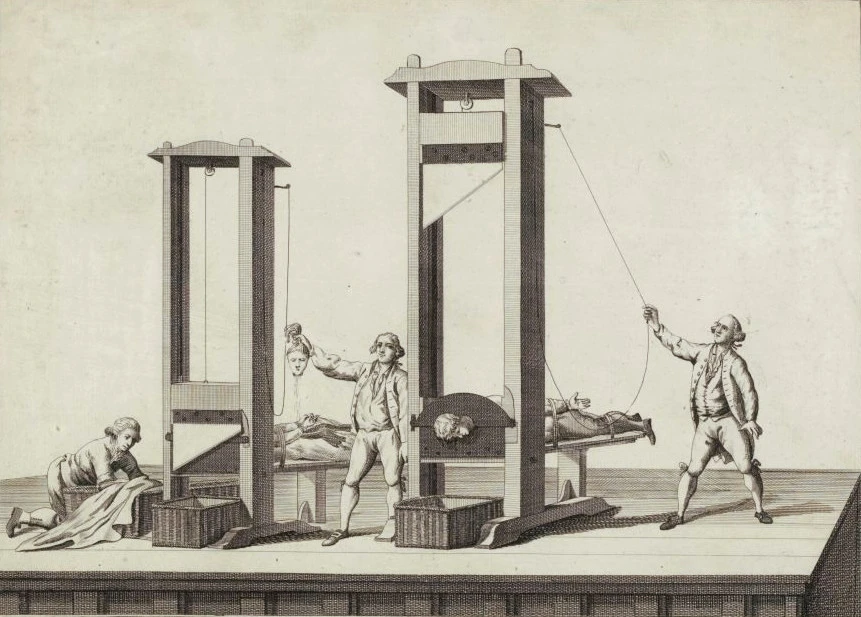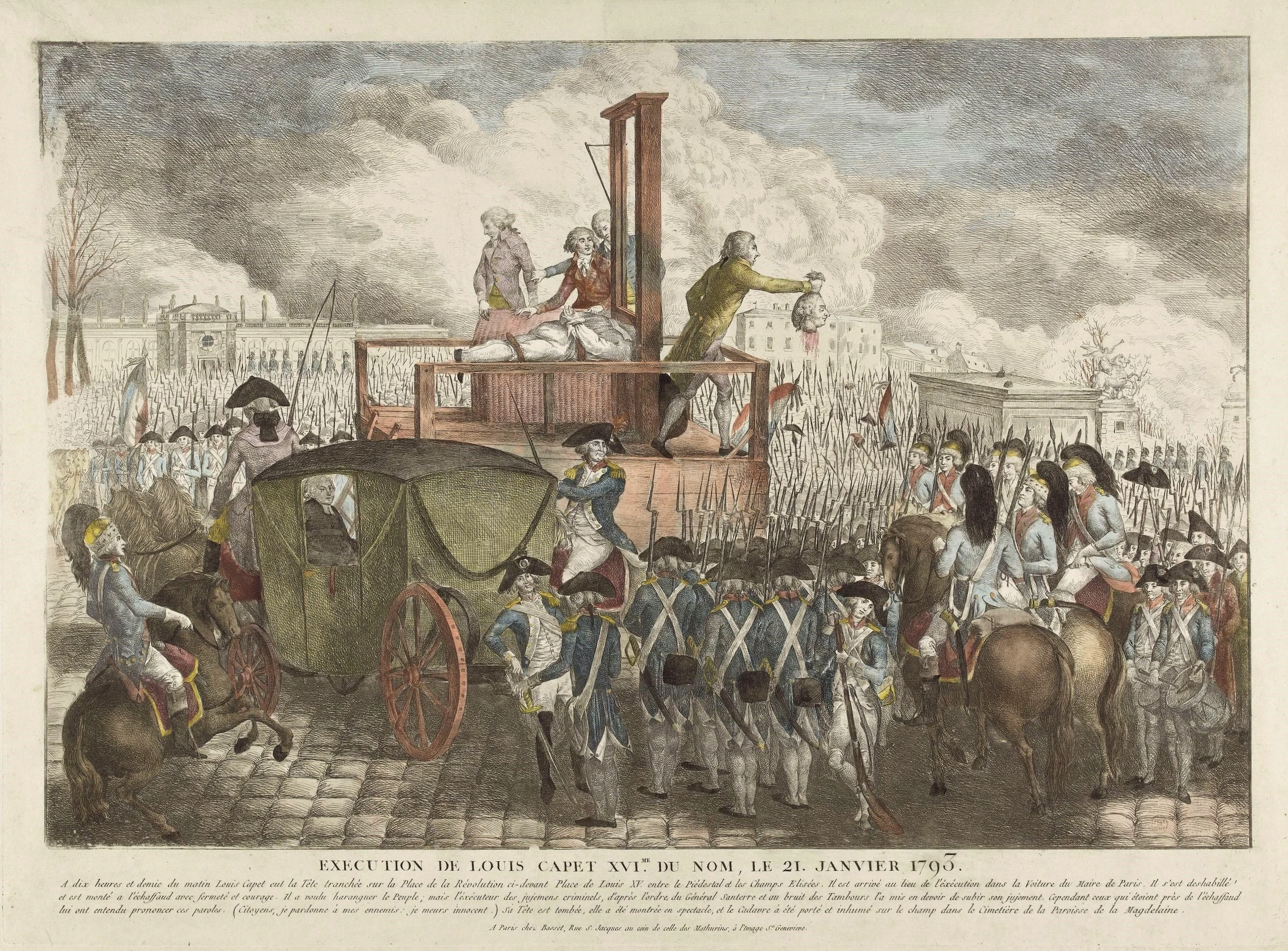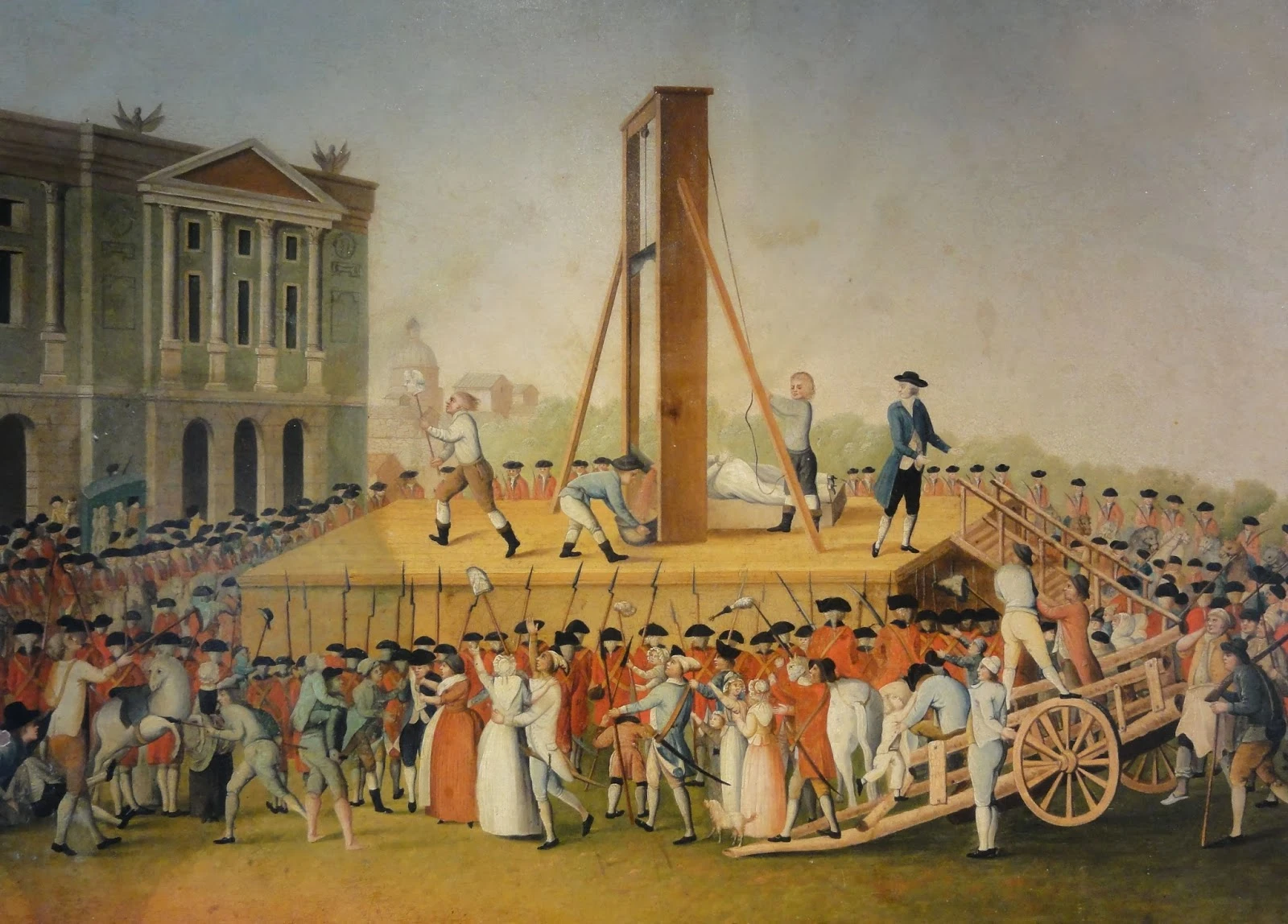there can be translation errors: our translator cut himself peeling vegetables, so the Spanish IT manager translated... It's a tough life!
Charles: the first Sanson to become an executioner... for love
At the end of the 17th century, Charles Sanson, a former officer from Normandy, married Marguerite Jouenne- young, pretty and the daughter of Rouen's executioner, Pierre Jouenne.In those days, if you married an executioner's daughter, you couldn't do anything else but execute. Executioners and their families formed a kind of caste that was completely ostracized in French society.In the Middle Ages, executioners lived outside the city walls, and had to be easy to spot in order to be avoided, often dressed in red, so that no one had the misfortune to speak to them. And when no one speaks to you, it's not easy to find a "shoe to fit", so very often the children of executioners married the children of executioners, unless someone came from the outside to marry a member of the family.This was the case for Charles, who married Marguerite, the daughter of "Monsieur de Rouen" - the executioner was given the name of the town where he worked, e.g. Monsieur de Paris, Monsieur de Lyon, etc.
An executioner at work (engraving from the Middle Ages) source wikipedia.
And when it's time to get down to work, things aren't going well at all.
Having become a hangman's son-in-law, and therefore hangman in his own right, Charles Sanson carried out his first execution in Rouen in 1675, and it went down in the annals of the trade for being ... a dud! On that day, Charles had to "break" a condemned man on the wheel, an atrocious (and public) torture.The condemned man lies on an X-shaped cross, and the executioner, armed with a huge iron bar, breaks the bones in his arms and legs, before snapping his hips and sternum and hoisting him onto a wheel on which, literally dementibed, the condemned man "gives up his soul to God when He pleases to take it", i.e. more or less long after being hoisted up. Some take hours to die.And it's this torture that Charles Sanson completely misses out on, as attested by old writings which say that "the executioner having forced his son-in-law, newly married, to strike the patient with the rod, the said son-in-law fell into a swoon and was covered in booing by the crowd".In short: Charles was sensitive, fainted and missed work - a disgrace for the family, and we can only imagine how much the father-in-law would yell at him in the evening. But he seems to have pulled himself together afterwards: widowed in 1685, he moved to Paris in 1687, where he became an executioner's helper, then an executioner himself (after his boss was arrested and convicted of pimping).Charles died in 1703, after having practiced until 1699 and having married, in second marriage, another hangman's daughter; Jeanne Dubut, this time the daughter of the Melun hangman.
The wheel torture as seen by Larousse editions (source wikipedia).
Charles II Sanson: a failed premiere followed by numerous "successes
From his marriage to Marguerite Jouenne, Charles had a son who would continue the family's vocation in the French capital: Charles II Sanson, born around 1681 in Rouen .His father's assistant executioner , he officially became executioner of Paris in 1707. He too had problems with the trade from day one, since on June 16, 1699 (he was only 18), he missed the execution of Angélique Nicole Carlier.It has to be said that the lady (sentenced to death for murdering her husband) was particularly beautiful, and she kissed his hand before he grabbed the sword intended to slice the condemned woman's neck. He had to do it 3 times... Suffice it to say that the audience hissed at him too.
Charles made up for it in later years, notably beating (better than his father!) the notorious bandit Cartouche, the Count of Horn (a cousin of the Regent) and hanging quite a few things.Married to Anne Marthe Dubut, sister of his father's wife (and daughter of the hangman of Melun), he was the father of Charles III Sanson. He died in Paris in 1726, leaving a 7-year-old son. His widow remarried with the help of her husband, François Prudhomme (a renowned torture specialist), who did the job until little Charles III was old enough to take his turn.
Charles III Sanson: executioner of the regicide Damiens.
The execution of Robert François Damiens by quartering in 1757 in Paris. By G.Garitan - Own work, CC BY-SA 4.0, https://commons.wikimedia.org/w/index.php?curid=126581195
Born in Paris in 1719, he officially became executioner of Paris at the age of 20 (when François Prudhomme, his father-in-law, returned the position to him). He married (obviously) a hangman's daughter, and even granddaughter, Jeanne Grabrielle Berger (a strong character, as we shall see). He is famous for having presided over the execution of Robert François Damiens, a man who tried to assassinate Louis XV by stabbing him in Versailles. For regicides, the punishment is terrible. Several of them, including the famous Ravaillac, murderer of Henri IV, endured it. The condemned man is taken to the scaffold, where he is "nipped at the udders, fat of the fat and legs", then his right hand is burned with sulfur fire, then molten lead and pitch are poured over the nipped wounds, and finally he is drawn apart by horses attached to his limbs. A dreadful torture, which Charles III can't actually perform, having been struck with apoplexy 3 years earlier, but he presides over what his brother, Nicolas, his former colleague François Prudhomme and... His own son Charles IV Sanson, who remained traumatized (as did his uncle Nicolas, who retired after the execution). It has to be said that it took over 60 throws of the horses and even the cutting of tendons to accomplish the task: François Robert Damiens was a force of nature. Charles III continued to preside over his son's work, notably the botched execution of Lally-Talendal, finishing the job himself by cutting the condemned man's neck (which his son literally hacked to pieces, missing every sword stroke).
Charles IV Henri Sanson; the star of the family.
Born on February 15, 1739, he studied in Normandy, before having to leave school when a parent realized he was the son of an executioner. The status of executioner hadn't changed at all in the 17th century, and an executioner was still ostracized. If you're the son of an executioner, you can't do anything other than be an executioner. That said, the "office" brought in a fair amount of money, which led Charles IV to take over from his father, even though he had no desire for the job, to ensure the family's subsistence. He began with the execution of the Chevalier de la Barre (the story of which Monsieur de France tells here), and continued with Antoine François Desrues (a poisoner who was burned alive), and Lally Talendal (1766), whose beheading with a sword he completely missed. So much so that his father, still an official executioner but half-paralyzed, had to come and finish the job. He became a titular executioner, and was well known to Parisians , who flocked to the Place de Grève (in front of City Hall) to watch the executions.
He was the first to use the guillotine
Instructions for using the guillotine from a late 18th-century encyclopedia.
Until 1789, executions were carried out in a variety of ways, depending on the sentence and social status. Nobles were beheaded by sword (and often missed). For commoners, there's hanging (and you can be hanged for theft), the stake (for heretics and poisoners), the wheel (which we told you about above), and even, for counterfeiters, being boiled alive . It was Doctor Louis, and the deputy Guillotin, who convinced the National Assembly that death was "sufficient" to pay for the crime , and that the condemned should not be made to suffer further. In 1791, the National Assembly decided that everyone should die the same death, and that "every condemned man shall have his head cut off". Charles Henri Sanson protests: it's not possible to carry out one execution after another, cutting off heads with swords. It's very physical and the sword would eventually become blunt. The guillotine (named after Dr. Guillotin, who promoted it but was horrified to be given his name) was conceived and installed: it cut off the head with equality, since nobles and commoners would henceforth die the same death, and, according to its designers, it was painless. A first trial was carried out on a sheep in 1792. Conclusive. This time, it was repeated on a man, Nicolas Jacques Pelletier, sentenced to death for theft and assault, and he was the first to perish on the guillotine in Paris on April 25, 1792. The Sansons and their helpers learn to use and even improve the machine. They even studied ways of dismantling and moving it (in particular, by checking that the machine is upright to prevent the blade from jamming if it is tilted).
The man who guillotined Louis XVI, Marie Antoinette and so many others
Execution of Louis XVI by Charles Henri SANSON on January 21, 1793 (Musée Carnavalet, Paris).
Charles IV is the "star" of the family, since in addition to the "usual" convicts (murderers, thieves...), he chopped off the heads of nearly 3,000 people between 1792 and October 1796 , including Louis XVI (January 21, 1793), Marie Antoinette (October 16), Danton, Camille Desmoulins, Robespierre, Saint-Just, Manon Roland... and many others. He sued for libel those who accused him of slapping Charlotte Corday's (who killed Marat) reddened head in front of the crowd. It was done by a carpenter who didn't work for him. On the other hand, it was to him that Danton said "you'll show my head to the People, it's worth it" . He is said to have asserted that if people saw an execution up close, and what happens after seeing the fear in the eyes of the condemned, there would be far fewer of them. He also defended the memory of Louis XVI when it was said that the king had shown cowardice. In fact, it's said that he was a monarchist, and it was in spite of himself that he had to cut off Louis XVI's head.
Gabriel Sanson: victim of a workplace accident
The son of Charles IV, he was born in 1769, assisted his father at executions and was due to take over "daddy's box" when he died of an accident at work. On that day in 1792, Gabriel slipped on the spilt blood and fell off the scaffold as he tried to show the crowd around the guillotine the head that had just fallen off. He broke his neck. It has to be said that the condemned were beheaded in "batches" (as some people called it at the time) arriving by charette, and all those severed heads generated a lot of blood. He is buried in Paris in the Cimetière de Montmartre with several members of his family.
Gabriel Sanson slipped to his death while brandishing a recently severed head (period engraving).
Henri Sanson penultimate
Born in 1767, he is one of the few people to have done "something other" than executioner, as he captained a gun crew in Paris and even got involved in politics, opposing Robespierre's arrest. He officially became executioner in 1795, executing Fouquier-Tinville, president of the revolutionary tribunal who had supplied the vast majority of Charles IV Sanson's death row inmates. He is also famous for having carried out several "multiple" executions, such as those in the Lyon mail affair.
Henri II Sanson le dernier: gay and a gambler
Born in 1799, he carried out "only" 18 executions in Paris (far behind his grandfather). He was the most original of the family, and that was his undoing. First of all, he's a gambler. He was often seen at the casino, losing astronomical sums to the point where he was imprisoned for debt. He went so far as to pawn the guillotine to get out of prison. Above all, it seems that Henri Sanson was gay. In any case, it was because he was seen in a house known for its homosexual residents that he was removed from the executioner's post. Officially for health reasons, unofficially because his name appeared on the Paris Prefecture's register of "pederasts". He died in 1889, and with him went this famous dynasty.
In Paris: City Hall, Condorde and Montmartre...
If you'd like to follow in the footsteps of the Sanson family, you can head for the town hall , since it was here, on the "place de grève" (because it ended in the sandy banks of the Seine), that the Sanson executioners officiated until the French Revolution. Next, the guillotine changed location several times before being installed on what is now the Place de la Concorde (in front of the Hôtel de la Marine). Finally, there is the Sanson family tomb in the small Montmartre cemetery .

